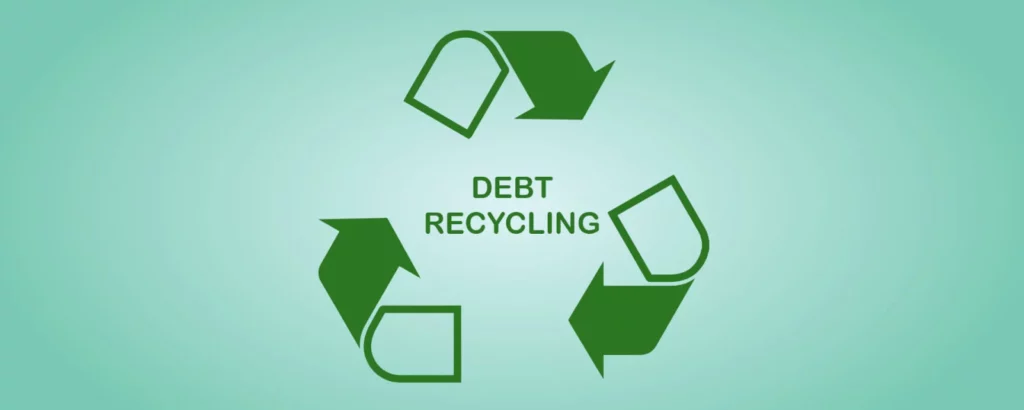The Mechanics of Debt Recycling: How It Works and Benefits You
Debt recycling is a financial strategy that can help individuals strategically manage their debts while simultaneously building wealth for the future. By understanding how debt recycling functions and its associated benefits, you can harness this approach to improve your financial health and secure long-term advantages.
Understanding the Concept of Debt Recycling
Debt recycling is a term used to describe the process of converting non-tax-deductible debt, such as personal loans or credit card debt, into tax-deductible debt, such as an investment loan. The objective is to leverage your assets by financial advisor Sydney for wealth management solutions to generate income and use that income to repay your debts strategically.
Defining Debt Recycling
In essence, debt recycling involves taking advantage of the tax benefits associated with investment loans and using these loans to pay off or reduce non-deductible debts. By doing so, individuals can potentially lower their tax liabilities while simultaneously reducing their debt burden.
The Basic Principles of Debt Recycling
Debt recycling operates on a few fundamental principles:
Identify non-tax-deductible debt
The first step in debt recycling is identifying your existing non-deductible debts, such as personal loans, credit card balances, or car loans. These debts do not provide any tax benefits.
Transition to tax-deductible debt
Once you identify your non-deductible debts, the next step is to transition them into tax-deductible debt. This can be achieved by refinancing your existing debts or taking out an investment loan.
Invest strategically
With your tax-deductible debt in place, the next crucial step is to invest the borrowed funds in income-generating assets such as shares, property, or managed funds. This ensures that you have a source of income to service your tax-deductible debt.
Utilize income to repay debts
As your investment generates income, it is important to use this income to repay your non-deductible debts. By doing so, you are effectively recycling your debts – converting non-tax-deductible debt into tax-deductible debt.
One important aspect to consider when implementing debt recycling is the potential risks involved. While debt recycling can be a powerful strategy for wealth creation, it is not without its challenges. It requires careful planning and monitoring to ensure that the investment returns are sufficient to cover the interest costs of the tax-deductible debt. Additionally, market fluctuations and changes in interest rates can impact the performance of the investments, which in turn affects the effectiveness of debt recycling.
Another factor to keep in mind is the importance of seeking professional advice when considering debt recycling. A financial advisor or tax specialist can provide valuable insights and guidance tailored to your specific financial situation. They can help you assess the feasibility of debt recycling, determine the most suitable investment options, and ensure compliance with tax laws and regulations.
Furthermore, it is crucial to regularly review and adjust your debt recycling strategy as your financial circumstances change. Life events such as job loss, marriage, or the birth of a child can impact your ability to generate income and service your debts. By staying proactive and adaptable, you can make informed decisions and optimize the benefits of debt recycling.
The Process of Debt Recycling
The process of debt recycling involves several steps that individuals need to follow:
Steps Involved in Debt Recycling
1. Review your current financial situation: Begin by assessing your current financial position and identifying your non-deductible debts. This will provide you with a clear understanding of your starting point.
2. Seek professional advice: Consulting with a financial advisor or mortgage broker who specializes in debt recycling can provide valuable insights tailored to your specific financial circumstances. They can help you determine if debt recycling is the right strategy for you.
3. Refinance or apply for an investment loan: If you decide to proceed with debt recycling, you will need to refinance your existing debts or apply for an investment loan. This will involve assessing the interest rates, features, and terms of different loan options to find the most suitable solution.
4. Invest strategically: Once you have secured your investment loan, you can start investing in income-generating assets. It is crucial to carefully consider your investment choices and seek professional advice to ensure you make informed decisions based on your risk tolerance and financial goals.
5. Monitor and adjust: Regularly review your investment performance and debt repayment progress. If necessary, make adjustments to your strategy to maximize the benefits of debt recycling.

The Role of Financial Institutions in Debt Recycling
Financial institutions such as banks, credit unions, and mortgage providers play a pivotal role in facilitating debt recycling. They offer various loan options, advise on investment opportunities, and ensure compliance with relevant regulations. Working closely with a reputable financial institution can streamline the process and optimize the outcomes.
When seeking professional advice for debt recycling, it is important to choose a financial advisor or mortgage broker who has extensive experience in this area. They should have a deep understanding of the intricacies involved in debt recycling and be able to provide you with tailored guidance that aligns with your financial goals.
Refinancing or applying for an investment loan can be a complex process, as it requires careful consideration of interest rates, loan features, and terms. It is advisable to compare different loan options and seek expert advice to ensure you choose the most suitable solution for your needs. A financial advisor or mortgage broker can assist you in navigating through the various loan options available and help you make an informed decision.
Investing strategically is a crucial aspect of debt recycling. It is essential to carefully analyze different investment opportunities and consider factors such as potential returns, risk levels, and diversification. Seeking professional advice from a qualified investment advisor can help you make well-informed investment decisions that align with your risk tolerance and financial objectives.
Financial institutions play a vital role in providing the necessary financial products and services for debt recycling. They offer a range of loan options, including refinancing and investment loans, to help individuals effectively manage their debts and invest in income-generating assets. Additionally, reputable financial institutions ensure compliance with relevant regulations, providing individuals with peace of mind and confidence in their debt recycling journey.
The Benefits of Debt Recycling
Debt recycling offers numerous benefits that can significantly impact your financial health in the long run.
How Debt Recycling Can Improve Your Financial Health
1. Tax savings: One of the primary advantages of debt recycling is that it allows you to convert non-deductible debts into tax-deductible debts. This can potentially result in substantial tax savings, as you can claim the interest payments on your investment loan as tax-deductible expenses.
2. Accelerated debt reduction: By channelling income generated from your investments towards repaying non-deductible debts, debt recycling enables you to pay off your debts more rapidly. This can free up additional funds and help you achieve financial freedom sooner.
3. Wealth creation: Debt recycling provides a powerful mechanism for wealth creation. By investing in income-generating assets, you can build a portfolio that generates long-term returns. Over time, this can help you accumulate wealth and increase your net worth.
Long-Term Advantages of Debt Recycling
1. Security in retirement: Debt recycling can contribute to building a secure retirement fund, as the income generated from your investments can be used as a source of retirement income.
2. Financial independence: By reducing your debts and building wealth through strategic investments, debt recycling can pave the way to financial independence. It provides a solid foundation for a more secure financial future.
3. Flexible investment opportunities: Debt recycling opens up a world of investment opportunities. By strategically investing in different asset classes, you can diversify your portfolio and potentially enjoy higher returns.
Risks and Considerations in Debt Recycling
Although debt recycling offers significant benefits, it is crucial to consider the risks and important factors before embarking on this financial strategy.
Potential Pitfalls of Debt Recycling
1. Investment risk: Investing means accepting a degree of risk, and there is no guarantee that your investments will always generate profits. It is important to carefully evaluate investment options and diversify your portfolio to minimize potential losses.
2. Interest rate changes: Debt recycling involves taking on additional loans, and any changes in interest rates can impact your financial position. It is essential to assess your ability to manage potential increases in interest rates and have contingency plans in place.
3. Potential capital gains tax: As you generate income from your investments, you may also incur capital gains tax liabilities. It is crucial to factor in these potential tax obligations and seek professional advice to ensure compliance with tax regulations.
Important Factors to Consider Before Recycling Debt
1. Financial goals: Consider your short-term and long-term financial goals. Debt recycling may not be suitable for everyone, so it is important to determine if it aligns with your objectives.
2. Risk tolerance: Assess your risk tolerance and understand the potential risks associated with the investments you intend to make. Ensure that your investment strategy aligns with your risk appetite.
3. Professional advice: Seek advice from financial experts who specialize in debt recycling. They can help you assess your financial situation, identify suitable investment opportunities, and navigate any legal and tax implications.

Strategies for Effective Debt Recycling
Implementing effective strategies can maximize the benefits of debt recycling and enhance your financial outcomes.
Tips for Successful Debt Recycling
1. Develop a comprehensive financial plan: A well-crafted financial plan provides a roadmap for achieving your goals. It allows you to identify the most effective debt recycling strategies based on your unique circumstances.
2. Regularly monitor your investments: Keep a close eye on the performance of your investments and adjust your strategy when necessary. Consider working with a professional investment advisor to gain insights and make informed decisions.
3. Focus on reducing non-deductible debts: Prioritize repaying your non-deductible debts to minimize your interest payments and accelerate your debt reduction.
Avoiding Common Mistakes in Debt Recycling
1. Overextending yourself: Excessive borrowing without considering your financial capacity can lead to financial strain. Ensure that you can comfortably manage your repayment obligations.
2. Neglecting diversification: Diversifying your investments across different asset classes and risk levels can help mitigate the impact of market fluctuations and reduce overall risk.
3. Failing to stay informed: Stay up to date with changes in tax laws, investment trends, and economic conditions. This awareness can help you make informed decisions and protect your financial interests.
In conclusion, debt recycling presents a powerful approach to managing your debts and building wealth. By converting non-deductible debts into tax-deductible debt while strategically investing, you can capitalize on tax benefits, accelerate debt reduction, and create long-term financial security. However, it is important to carefully consider the risks, seek professional advice, and implement effective strategies to maximize the benefits of debt recycling. Embrace this financial strategy and take control of your financial future.

